Ft. Davis
Restored Western Cavalry Fort
Ft. Davis, Texas
March, 2005
We  visited Ft. Davis while we were staying in a nearby RV Park called "The
Prude Ranch". We saw the Fort as we drove through the small town in route
to our campground. Unfortunately much of the Fort had been razed but the
foundations of many of the buildings remained. Also, there were a number of
placards and many of the buildings had been rebuilt and had much information on
the history of the area.
visited Ft. Davis while we were staying in a nearby RV Park called "The
Prude Ranch". We saw the Fort as we drove through the small town in route
to our campground. Unfortunately much of the Fort had been razed but the
foundations of many of the buildings remained. Also, there were a number of
placards and many of the buildings had been rebuilt and had much information on
the history of the area.
Set in the rugged beauty of the Davis Mountains of west Texas, Fort Davis is one
of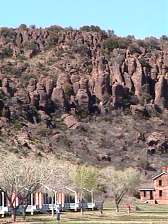 America's best surviving examples of an Indian Wars' frontier military post
in the Southwest. Fort Davis is important in understanding the presence of
African Americans in the West and in the frontier military because the 24th and
25th U.S. Infantry and the 9th and 10th U.S. Cavalry, all-black regiments
established after the Civil War, were stationed at the post.
Today, Fort Davis can boast what is considered the finest restored western
cavalry post in the United States.
America's best surviving examples of an Indian Wars' frontier military post
in the Southwest. Fort Davis is important in understanding the presence of
African Americans in the West and in the frontier military because the 24th and
25th U.S. Infantry and the 9th and 10th U.S. Cavalry, all-black regiments
established after the Civil War, were stationed at the post.
Today, Fort Davis can boast what is considered the finest restored western
cavalry post in the United States.
A key post in the
defense system of western Texas, Fort Davis played a major role in the history
of the Southwest. From 1854 until 1891, troops
stationed at the post protected immigrants, freighters, mail coaches, and
travelers on the San Antonio-El Paso Road. It is a vivid reminder of the
significant role played by the military in the settlement and development of the
western frontier.
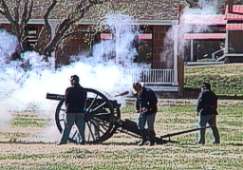 Named
for Secretary of War Jefferson Davis, the fort was first garrisoned by
Lieutenant Colonel Washington Seawell and six companies of the Eighth U.S.
Infantry. The post was located in a box canyon near Limpia Creek on the eastern
side of the Davis Mountains--where wood, water, and grass were plentiful. From
1854 to 1861 , troops of the Eighth Infantry spent much of their time in the
field pursuing Comanches, Kiowas, and Apaches who terrorized travelers and
attacked mail stations. With the outbreak of the Civil War and Texasís
secession from the Union, the federal government evacuated Fort Davis. The fort
was occupied by Confederate troops from the
Named
for Secretary of War Jefferson Davis, the fort was first garrisoned by
Lieutenant Colonel Washington Seawell and six companies of the Eighth U.S.
Infantry. The post was located in a box canyon near Limpia Creek on the eastern
side of the Davis Mountains--where wood, water, and grass were plentiful. From
1854 to 1861 , troops of the Eighth Infantry spent much of their time in the
field pursuing Comanches, Kiowas, and Apaches who terrorized travelers and
attacked mail stations. With the outbreak of the Civil War and Texasís
secession from the Union, the federal government evacuated Fort Davis. The fort
was occupied by Confederate troops from the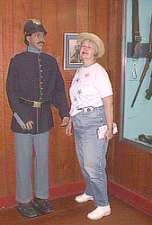 spring
of 1861 until the summer of 1862, when Union forces again took possession. They
quickly abandoned
the post and Fort Davis lay deserted for the next five years.
spring
of 1861 until the summer of 1862, when Union forces again took possession. They
quickly abandoned
the post and Fort Davis lay deserted for the next five years.
The original post consisted of primitive structures. (It was located west of the
present day Officersí Row. The foundations of several buildings from this
earlier fort can still be seen today.) Not many of the fortís structures
remained in June 1867, when Lieutenant Colonel Wesley Merritt and four companies
of the recently-organized
Ninth U.S. Cavalry reoccupied Fort Davis. The building of a new post, just east
of the original site, began immediately. By the end of 1869, a number of
officersí quarters, two enlisted menís barracks, a guardhouse, temporary
hospital, and storehouses had been erected. Construction continued through the
1880s. By then, Fort Davis had become a major installation with more than 100
structures, and quarters for more than 400 soldiers.
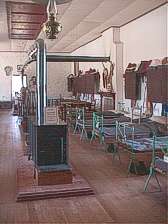 Fort
Davisís primary role of safeguarding the west Texas frontier against the
Comanches and Apaches continued until 1881. Although the Comanches were defeated
in the mid-1870s, the Apaches continued to make travel on the San Antonio-El
Paso road dangerous. Soldiers from the post regularly patrolled the road and
provided protection for wagon trains and mail coaches. The last major military
campaign involving troops from Fort Davis occurred in 1880. In a series of
engagements, units from Fort Davis and other posts, under the command of Colonel
Benjamin Grierson, forced the Apaches and their leader Victorio into Mexico.
There, Victorio and most of his followers were killed by Mexican soldiers.
Fort
Davisís primary role of safeguarding the west Texas frontier against the
Comanches and Apaches continued until 1881. Although the Comanches were defeated
in the mid-1870s, the Apaches continued to make travel on the San Antonio-El
Paso road dangerous. Soldiers from the post regularly patrolled the road and
provided protection for wagon trains and mail coaches. The last major military
campaign involving troops from Fort Davis occurred in 1880. In a series of
engagements, units from Fort Davis and other posts, under the command of Colonel
Benjamin Grierson, forced the Apaches and their leader Victorio into Mexico.
There, Victorio and most of his followers were killed by Mexican soldiers.
With the end of the Indian Wars in west Texas, garrison life at Fort Davis
became more routine. Soldiers occasionally escorted railroad survey parties,
repaired roads and telegraph lines, and pursued bandits. In June 1891, as a
result of the armyís efforts to consolidate its frontier garrisons, Fort Davis
was ordered abandoned, having "outlived its usefulness. "Seventy years
later, in 1961, the fort was authorized as a national historic site, a unit of
the National Park Service.
Today,
twenty-four roofed buildings and over 100 ruins and
foundations are part of Fort
Davis National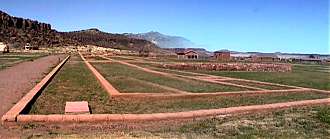 Historic Site. Five of the historic buildings have been
refurnished to the 1880s, making it easy for visitors to envision themselves
being at the fort at the height of its development.
Historic Site. Five of the historic buildings have been
refurnished to the 1880s, making it easy for visitors to envision themselves
being at the fort at the height of its development.
The Fort has reenactments on a daily schedule, which include firing off their
canons. Fort Davis National Historic Site is open everyday, seven days a week from
8-5 in the winter and 8-6 during the summer.
The Historic Site is only a beginning of what a visitor can enjoy in Fort Davis.
The town has numerous places to stay including a historic hotel, motels, bed and
breakfasts, an RV park with camp grounds, restaurants and several very nice gift
shops. Nearby is the Davis Mountains State Park with both accommodations and a
restaurant. Fort Davis is the gateway to the spectacular Big Bend country, which
lies south and southeast. This is the wonderland of Texas, and anyone visiting
it should be sure to experience Fort Davis.
Good Luck! Have Fun! and Stay Safe!
Laura